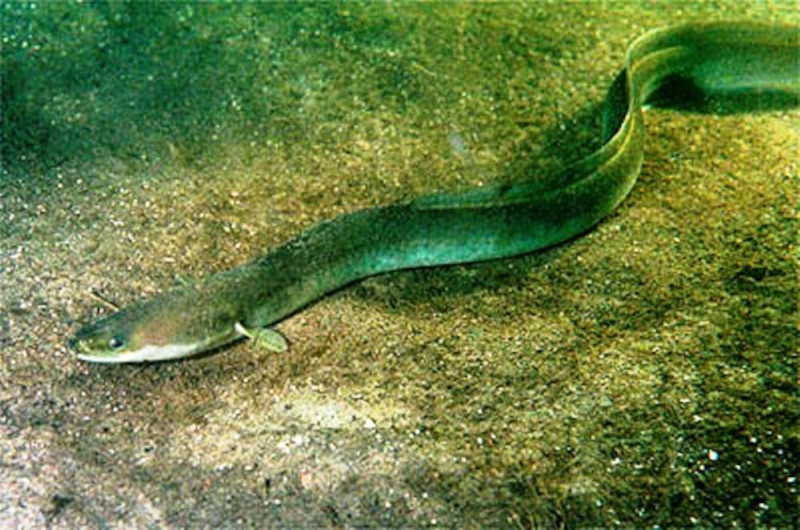European Eel Facts
- This creation of Nature and evolution most frequently goes by the somewhat deceptive common name of the European Eel. It’s also known by a variety of alternate monikers. These include such terms as River Eel, Common Eel, Glass Eel, and Weed Eel.
- Among professionals, such as researchers, though, it’s usually referred to by its technical name. That’s the strangely repetitive term of Anguilla anguilla. As such titles go, though it may seem odd, it’s actually fairly simple, compared to other such names.
- The animal originally bore another technical name, however. In fact, in the annals of science it’s been classified under several. The original term assigned to it, though, was that of Muraena anguilla. This ocurred due to reclassification of the remarkable species.
- The credit for the original name, though, goes to the renowned Swedish researcher, Carl Linnaeus. That’s because he made the first known official recognition of it as a separate and distinct species. This scientifically noteworthy deed he accomplished in 1758.
- Sadly, however, its numbers appear to have been drastically reduced. This unfortunate fact seems to hold true throughout the entirety of its known natural range. The IUCN, therefore, presently lists the European Eel as Critically Endangered on its Red List.
- Factors contributing to its plummeting numbers include migration barriers, such as dams, and overfishing. It also faces threats posed by changes to its habitat, largely due to human activities. And, it also faces the threat of climate change, like all of us.
Related Articles
European Eel Physical Description
The remarkable European Eel certainly draws the attention of those who encounter it. That’s simply because it’s a fascinating animal. For most individuals, though, the most impressive thing about this creature is its physical appearance. That includes its sheer physical size.
Specimens attain a respectable growth. Like most its kindred, it also displays only an extremely small degree of the physiological characteristic of sexual dimorphism. In its case, also as in other eels, the only noticeable difference occurs in the structure of the gonads.
Individuals of both genders appear otherwise indistinguishable to the non-professional. On average, members of this species attain a body length of 2.0 – 2.6 ft (60 – 80 cm). Exceptional specimens do occur, however. These sometimes reach up to 59 in (1.5 m).
As is immediately obvious to the observer, the body develops as highly elongated. That’s typical of all its relatives. This particular species, though, has a somewhat more rounded shape than some others. This trait gives the creature a more snake-like shape than some eels.
Other physical traits of the European Eel also remain quite similar to the rest of its Order. This includes the presence of small, slit-like gills. It also displays pectoral fins, but not pelvic. It’s overall color scheme consists of yellowish-brown, mainly on the stomach and sides.
- Kingdom: Animalia
- Phylum: Chordata
- Class: Actinopterygii
- Order: Anguilliformes
- Family: Anguillidae
- Genus: Anguilla
- Species: A. anguilla
European Eel Distribution, Habitat, and Ecology
The intriguing European Eel evolved as native to a much broader range of the globe than its common name suggests. That’s due to the fact that this marvel of Nature developed as endemic to extensive areas of the Atlantic Ocean. Within that, though, it’s range is specific.
More precisely, the vast majority of specimens make their home in the coastal regions. This does include in Europe, of course, from the White Sea to the Black Sea. It also appears from Scandinavia to Morocco. This gives it a simultaneously broad yet selective range.
Defining its habitat also qualifies as complicated. This holds true due to the nature of its evolutionary path. The greatest portion of its population begin their lives in the main spawning area. This region lies within the section of the ocean known as the Sargasso Sea.
Early in their larval stage, however, individuals migrate to inland, freshwater waterways. These include various lakes and rivers. Some, though, also appear in more brackish waters, such as estuaries. They return to the sea, though, to spawn. Each then dies soon after.
Mature specimens of the European Eel develop as nocturnal in their habits. At night, each hides in the mud, or stones and such. They typically emerge only at night. During most of its life, each individual lives a mainly solitary existence. The lone exception’s during spawning.
It feeds on a wide variety of prey. This mostly consists of molluscs, worms, crustaceans, and insects. It also consumes carrion opportunistically. It itself has few natural predators. Its lifespan in the wild is unknown, but captive specimens live as much as 80 years or more.
Species Sharing Its Range
Check out our other articles on 5 Magnificent Mammals of Colombia, Baikal Seal, Onyx River, American Wintergreen, Blood Shrimp, Delta Green Ground Beetle, American Alligator

